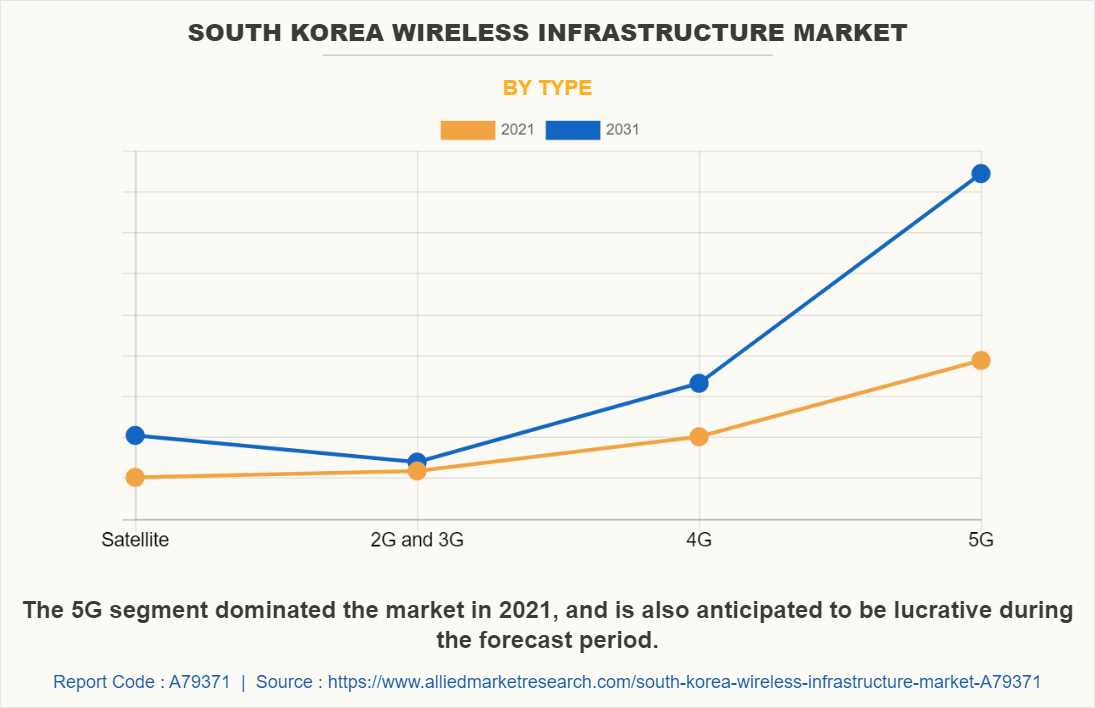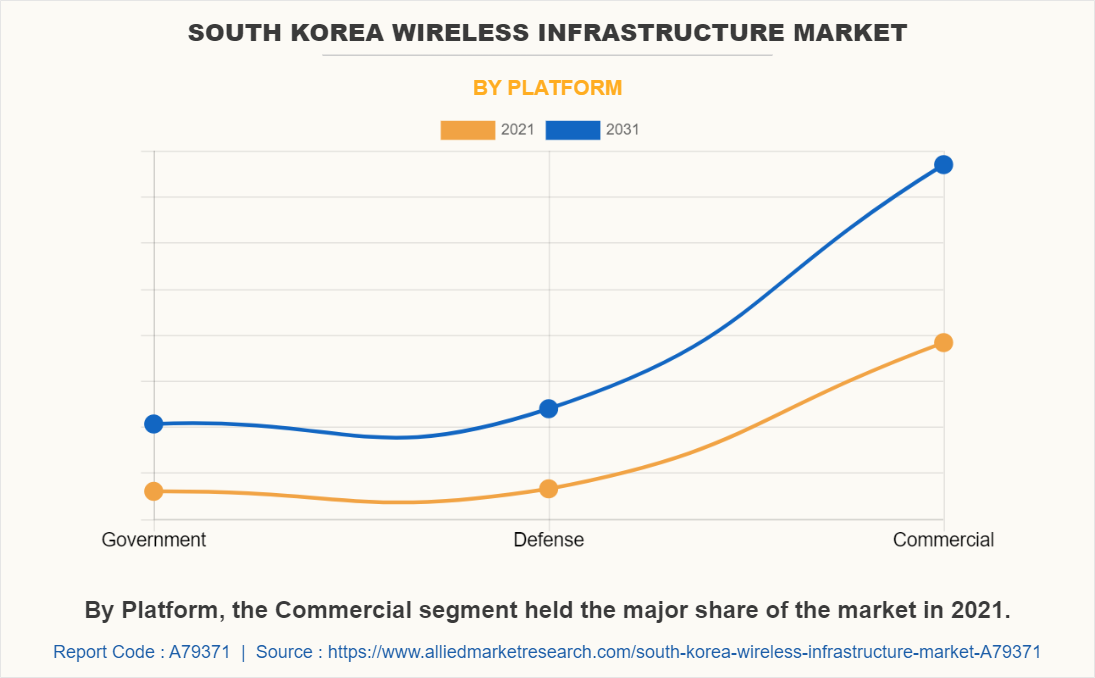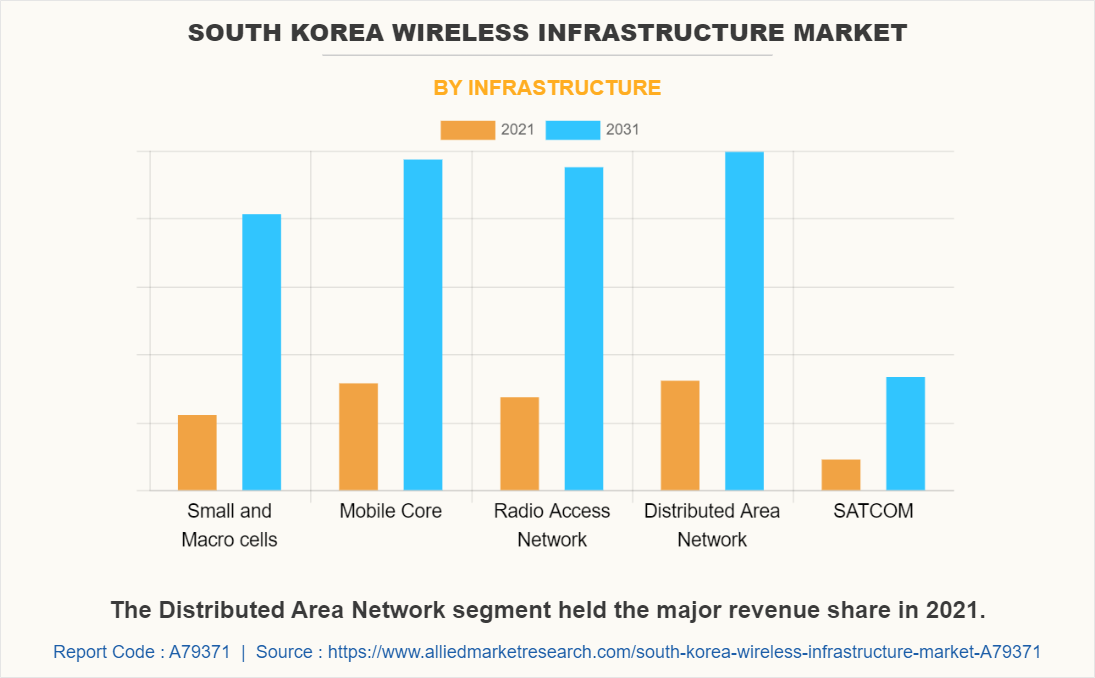The South Korea wireless infrastructure market is anticipated to witness substantial growth during the forecast period. This is attributed due to the surge in the demand for enhanced connectivity, a voracious appetite for data, and the inexorable march toward 5G technology. In addition, the government's initiatives to promote digital infrastructure and technological innovation fuel the growth of the market. The Korean government's vision for a "Digital New Deal" and the ambitious "K-New Deal" plan have set the stage for substantial investments in the wireless infrastructure sector.

However, the delicate balance between privacy, security, and connectivity acts as a major restraint to the market growth. In addition, the high investments and economic uncertainties hamper the growth of the market.

On the other hand, the South Korea wireless infrastructure market is expected to offer several opportunities for new players in the market. The advent of 5G technology offers lucrative opportunities for the growth of the market. In addition, the proliferation of IoT (Internet of Things) devices for augmented reality and virtual reality applications offers remunerative opportunities for the growth of the market. Furthermore, stringent government regulations pertaining to cybersecurity concerns offer new avenues for the growth of the market.

The South Korea wireless infrastructure market is expected to witness several future trends for market growth. The South Korea wireless infrastructure market is expected to witness several future trends for market growth. Rise in 5G technology is the current trend in the market. Another trend is the surge in the mobile core, radio access network, and distributed area network segments.

The South Korea wireless infrastructure market is segmented into type, platform, and infrastructure. On the basis of type, the market is categorized into satellite, 3G, 4G, and 5G. By platform, the market is segregated into government, defense, and commercial. Depending on the infrastructure, the market is divided into small and macro cells, mobile core, radio access network, distributed area network, and SATCOM. The segments of small and macro cells, mobile core, radio access network, and distributed area network play pivotal roles. The small cell segment is poised for exponential growth, driven by the need for localized and high-capacity connectivity.
Qualitative insights represent remarkable developments in the South Korea wireless infrastructure market. Companies are focusing on new product development to create solutions that cater to the evolving demands of South Korea's tech-savvy population. Companies are investing heavily in R&D to maintain their edge in this competitive market. Companies are focusing on understanding consumer/end-user perceptions by fulfilling their demands for seamless connectivity, leading to heightened expectations from wireless infrastructure providers. Companies are exploring different pricing models to offer affordable options while maintaining their profit margins.
The Porter’s five forces analysis is a model, which analyzes the competitive scenario of the industry and role of each stakeholder. The five forces include the bargaining power of buyers, the bargaining power of suppliers, the threat of new entrants, the threat of substitutes, and the level of competitive rivalry. The threat of new entrants is a paradoxical force. The market is open to innovation, with opportunities for new players to introduce novel solutions. On the other hand, the high capital requirements and stringent regulations create barriers to entry, making it a formidable challenge. The bargaining power of suppliers can be enigmatic. For niche components and technologies, suppliers may wield considerable power. However, for commoditized elements, the market exerts downward pressure on pricing, creating a dynamic balance. The bargaining power of buyers is a discerning lot. Their preferences and expectations drive competition among providers. The abundance of choices, coupled with the influence of consumer perceptions, enhances their bargaining power. The threat of substitutes is a perplexing force. While wireless infrastructure is vital for connectivity, emerging technologies may offer alternative solutions. Companies in this market must constantly innovate to mitigate the threat of substitutes. The rivalry among existing competitors is intense. The pursuit of market share and the development of cutting-edge solutions create a competitive atmosphere that defines the market's complexity.
A SWOT analysis provides an overview of the South Korea wireless infrastructure market It includes its internal strength, weakness, opportunities and threats. The market's strengths lie in its advanced technological capabilities, particularly in the 5G segment. South Korea's commitment to digital innovation and its tech-savvy population creates a fertile ground for wireless infrastructure growth. The presence of established players with significant expertise is another strength. The market's weaknesses are embodied in its regulatory complexities, high capital requirements, and the perpetual need for R&D. Navigating these intricacies can be challenging for businesses entering the market. Economic uncertainties also pose a vulnerability. The market is ripe with opportunities, particularly in the realm of 5G technology. The potential for IoT, augmented reality, and secure communication networks presents an expansive landscape for growth. In addition, the commercial sector offers untold opportunities, driven by the demand for connectivity across various industries. The threats in this market are multifaceted. Regulatory hurdles can impede growth, and the competitive landscape poses challenges for market entrants. The threat of technological substitutes and economic fluctuations add to the market's complexity.
The key players operating in the South Korea wireless infrastructure market Samsung Electronics, SK Telecom, KT Corporation, LG Uplus, Huawei Technologies, Ericsson, Nokia Corporation, ZTE Corporation, Cisco Systems, and NEC Corporation.
Key Benefits For Stakeholders
- Enable informed decision-making process and offer market analysis based on the current market situation and estimated future trends.
- Analyze the key strategies adopted by major market players in South Korea wireless infrastructure market.
- Assess and rank the top factors that are expected to affect the growth of the South Korea wireless infrastructure market.
- Top Player positioning provides a clear understanding of the present position of market players.
- Detailed analysis of the South Korea wireless infrastructure market segmentation assists to determine the prevailing market opportunities.
- Identify key investment pockets for various offerings in the market.
South Korea Wireless Infrastructure Market Report Highlights
| Aspects | Details |
| Forecast period | 2021 - 2031 |
| Report Pages | 89 |
| By Type |
|
| By Platform |
|
| By Infrastructure |
|
| Key Market Players | SK Broadband, Datamaster, SK Telecom, E-Post Bank, LG Electronics, Hyundai Motor Company, Samsung Electronics, LG Uplus, KT Corporation, Hanaro Telecom |
The South Korea Wireless Infrastructure Market is estimated to reach $15.2 billion by 2031
LG Electronics, Samsung Electronics, KT Corporation, SK Telecom, SK Broadband, LG Uplus, Hyundai Motor Company, Datamaster, E-Post Bank, Hanaro Telecom are the leading players in South Korea Wireless Infrastructure Market
1. Enable informed decision-making process and offer market analysis based on current market situation and estimated future trends.
2. Analyze the key strategies adopted by major market players in south korea wireless infrastructure market.
3. Assess and rank the top factors that are expected to affect the growth of south korea wireless infrastructure market.
4. Top Player positioning provides a clear understanding of the present position of market players.
5. Detailed analysis of the south korea wireless infrastructure market segmentation assists to determine the prevailing market opportunities.
6. Identify key investment pockets for various offerings in the market.
South Korea Wireless Infrastructure Market is classified as by type, by platform, by infrastructure
Loading Table Of Content...
Loading Research Methodology...



